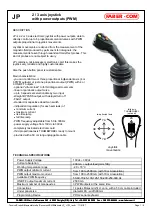
Cable and Wire Length
Guidelines
defines cable length guidelines for the various
wire sizes that may be used for wiring low-voltage (<30V)
input and outputs.
Table 4: Cable Length Guidelines for Recommended Wire Sizes for Low-Voltage (<30V) Inputs and Outputs
Assumptions
Maximum Cable
Length and Type
Wire Size/Gauge and Type
Guideline
100 mV maximum voltage drop
Depending on cable and the connected input
or output device, you may have to define an
offset in the setup software for the input or
output point.
457 m (1,500 ft) twisted
wire
1.5 mm
2
(18 AWG) stranded copper
A
297 m (975 ft) twisted wire
0.8 mm (20 AWG) stranded copper
183 m (600 ft) twisted wire
0.6 mm (22 AWG) stranded copper
107 m (350 ft) twisted wire
N/A (24 AWG) stranded copper
100 mV maximum voltage drop
Depending on cable and the connected input
or output device, you may have to define an
offset in the setup software for the input or
output point.
229 m (750 ft) twisted wire
1.5 mm
2
(18 AWG) stranded copper
B
137 m (450 ft) twisted wire
0.8 mm (20 AWG) stranded copper
91 m (300 ft) twisted wire
0.6 mm (22 AWG) stranded copper
61 m (200 ft) twisted wire
N/A (24 AWG) stranded copper
N/A
See
to determine
cable length. Use twisted
wire cable.
See
to select wire size/gauge.
Use stranded copper wire
C
1
The required wire sizes and lengths for high-voltage (>30V) Relay Outputs are determined by the load connected to the relay,
and local, national, or regional electrical codes.
17
FX-PCA2611-0 Advanced Application Programmable Controller Installation Instructions










































